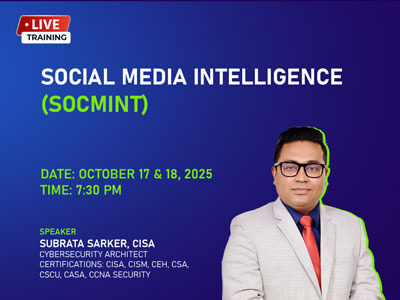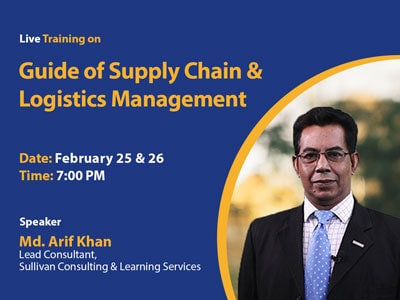Guide of Supply chain & Logistics Management
Guide of Supply chain & Logistics Management Overview of the training: In today’s global competitive environment; organizations survive by leveraging their often complex supply chains to provide value to customers. Organizations must be able to provide the right goods and services to the right customers, in the right quantity, in the right place and time, and at the right costs. Failure to do so could have a significant negative impact on the bottom-line. Supply Chain Management (SCM) is the design, planning, execution, control, and monitoring of supply chain activities with the objective of creating net value, building a competitive infrastructure, …
Curriculum
- 1 Section
- 5 Lessons
- 204 Weeks
- Guide of Supply chain & Logistics Management5
Overview
Guide of Supply chain & Logistics Management
Overview of the training:
In today’s global competitive environment; organizations survive by leveraging their often complex supply chains to provide value to customers. Organizations must be able to provide the right goods and services to the right customers, in the right quantity, in the right place and time, and at the right costs. Failure to do so could have a significant negative impact on the bottom-line.
Supply Chain Management (SCM) is the design, planning, execution, control, and monitoring of supply chain activities with the objective of creating net value, building a competitive infrastructure, leveraging worldwide logistics, synchronizing supply with demand, and measuring performance globally.
Supply chain management deals with inputs, conversion, and outputs. A supply chain consists of three types of entities: customers, a producer, and the producer’s suppliers. Supply chain management oversees and optimizes the processes of acquiring inputs from suppliers (purchasing), converting those inputs into a finished product (production), and delivering those products – or outputs – to customers (fulfillment).
Supply chain managers decide where to locate manufacturing and distribution facilities, how to route goods and materials among those facilities, and from which parts of the world to source the inputs.
Who should attend?
The professionals engaged in Supply Chain, Export, Import, Procurement, Logistics, Distribution, Shipping, Freight Forwarding, Customs, Courier, Supply, Marketing, Specially Fresher, Post Graduate Business Students, SCM Training and more those are involved in Private Sector, Public sector, and Nonprofit organizations (NGOs)
Objectives of this training:
- Explain the modern concept, tools, models, and analysis of SCM and LM
- It aims to provide participants foundational and advanced knowledge on how to tackle, resolve, and manage myriad complex problems and issues that confront supply chain managers.
- The purpose of the course is to recognize the interrelationship of supply chain functions and to understand how all parts of the supply chain work.
- Professional involves in Supply Chain Management(SCM) as they can minimize cost
- Supply the products and services to the right places at the right time and satisfy the customer
Learning Methodology:
- Online Lecture & discussion
- Power point Presentation
- Peer learning
- Online Group work and presentation
- Experience sharing
- Buzz and simulation games
- Case study exercises
- Video clip
Training Contents:
- Real meaning of Supply Chain Management (SCM)
- Real meaning of Logistics Management
- Contributors in Supply Chain
- Local, International and Global Supply Chain Management
- Major Supply Chain activities of an organization
- Supply Chain Departmental Functions
- Importance and Benefits of SCM
- Taking Competitive advantage through Supply chain
- Supply Positioning Model analysis
- Supplier and Supplier Country Analysis
- Buyer and Buyer Country Analysis
- Supplier Perception Model analysis
- Life Cycle Cost analysis
- Suppliers Offer Analysis (selecting the best offer)
- Supply Chain System /Procedure in Manufacturing Organization
- Supply Chain System /Procedure in Trading Organization
- Requirement Planning in Supply Chain
- Negotiation techniques in Supply Chain
- Required Negotiation skills in the purchasing field
- Quality of Successful negotiators
- How to make a good contract in Business
- Avoiding contractual default
- Settling Disputes in Supply Chain : Dispute Resolution Method
- Procurement Management (Local, International and Public Procurement Method)
- Principal payment methods in Supply Chain
- Logistics drivers
- Inventory management
- Transportation Management
- Packaging
- Warehousing
- Distribution Management
- Supply Chain Performance Management
- Learning Check
- SCM CASES, EXERCISES, VIDEO, GAME, ROLE PLAY
Note:
- After completing every lesson click on the “COMPLETE ” button the go to the next lesson.
- Must set up your first name, last name, and display name from settings of your profile for your certificate. [Log in> Profile> Settings> General> Fill up the required fields> Save Changes ]
- Do not click on the “FINISH COURSE” button without watching all the videos.
- After watching all the videos click on the “FINISH COURSE ”button then the Certificate will be generated.
- More details: https://thrivingskill.com/faqs/
Training Instructor:
Courses of this Instructor:







